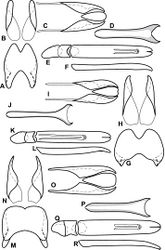Baconia emarginata
| Notice: | This page is derived from the original publication listed below, whose author(s) should always be credited. Further contributors may edit and improve the content of this page and, consequently, need to be credited as well (see page history). Any assessment of factual correctness requires a careful review of the original article as well as of subsequent contributions.
If you are uncertain whether your planned contribution is correct or not, we suggest that you use the associated discussion page instead of editing the page directly. This page should be cited as follows (rationale):
Citation formats to copy and paste
BibTeX: @article{Caterino2013ZooKeys343, RIS/ Endnote: TY - JOUR Wikipedia/ Citizendium: <ref name="Caterino2013ZooKeys343">{{Citation See also the citation download page at the journal. |
Ordo: Coleoptera
Familia: Histeridae
Genus: Baconia
Name
Baconia emarginata Caterino & Tishechkin, 2013 sp. n. – Wikispecies link – ZooBank link – Pensoft Profile
Type locality
BRAZIL: Pará: Tucuruí [3.75°S, 49.67°W].
Type material
Holotype male: “BRASIL: Pará, Tucuruí. 3°45'S, 49°40'W, 27.x.–9.xi.1985, FIT” / “Caterino/Tishechkin Exosternini Voucher EXO-00486” (UFPR). Paratypes (2): 1: BRAZIL: Mato Grosso:Mpio. Cotriguaçu, Fazenda São Nicolau, Prainha, 9°51.6'S, 58°12.9'W, ix.2009, FIT, R. Nunes (CEMT). 1: FRENCH GUIANA: Montagne des Chevaux, 4°43'N, 52°24'W, 16.xii.2008, FIT, SEAG (CHND).
Other material
PERU:1: Junín: 11 km NE Puerto Ocopa, Los Olivos, 11°3.00'S, 74°15.52'W, 1200 m, 29-30.iii.2009, FIT, A. Tishechkin, DNA Extract MSC-2148, EXO-00675 (AKTC).
Diagnostic description
Length: 2.2–2.3mm, width: 2.0–2.1mm; body rather broadly elongate oval, convex, glabrous; piceous, shining; frons elevated over antennal bases, depressed in middle, interocular margins convergent dorsad, frontal disk with few coarse punctures in median depression, epistoma with fairly discrete median fovea, otherwise impunctate, frontal stria present along inner edges of eyes, interrupted above antennal bases and at middle; supraorbital stria absent; antennal scape short, club broadly rounded, slightly asymmetrical; labrum with distal edge weakly carinate, deeply emarginate; mandibles rather short, stout, each with basal tooth; pronotal sides evenly narrowed in basal two-thirds, more strongly arcuate to apices, lateral marginal striae continuous around sides and front, submarginal stria absent, anterior corners of pronotal disk depressed, coarser secondary punctures of pronotal disk present only in lateral thirds; elytra with complete inner epipleural stria and fragments of an additional outer epipleural stria, outer subhumeral stria absent, inner subhumeral stria present as short basal and median fragments, dorsal striae 1-2 more or less complete, either or both variably obsolete anteriorly, 3rd stria present in basal half, very fine, scratchlike, 4th stria present as very short basal arch, obsolete in apical three-fourths or more, 5th stria absent, sutural stria present for short distance at middle, narrowly separated from basal arch of 4th, elytral disk with small, sparse punctures in apical fourth; prosternal keel moderately broad, weakly convex, emarginate at base, carinal striae convergent between coxae, diverging anterad and posterad, complete, free; prosternal lobe short, less than one-half keel length, apical margin rounded, marginal stria well impressed at middle, obsolete at sides; mesoventrite weakly produced at middle, marginal stria interrupted medially; mesometaventral stria transverse, crenulate, meeting base of inner lateral metaventral stria, which is displaced slightly mediad, curving obliquely posterolaterad toward middle of hind coxa, slightly abbreviated at apex, outer lateral metaventral stria subparallel, about half as long as inner; metaventral and abdominal disks impunctate at middle; abdominal ventrite 1 with inner lateral stria present in basal half only, outer lateral stria absent; protibiae 4-dentate, marginal spines fine, not prominent, outer margin finely serrulate between; mesotibia with one marginal spine; outer metatibial margin smooth; propygidium lacking basal stria, with coarse secondary punctures separated by about their diameters in basal third, smaller and much sparser posterad, propygidial glands visible about one-fourth from basal and anterolateral margins; pygidium with fine ground punctation very sparsely interspersed with small secondary punctures, predominantly in basal third. Male genitalia (Figs 29G–L): T8 shorter than broad, widest at middle, sides outwardly arcuate, basal emargination shallow, sinuate, basal rim not strongly sclerotized, apex narrowly emarginate, ventrolateral apodemes projecting weakly beneath, about one-fourth from base, separated by about three-fourths maximum T8 width, rapidly narrowed before longitudinal midpoint; S8 divided, longer than T8, inner margins approximate only in basal fourth, divergent apically, outer margins straight, subparallel, apical guides slightly widened distally, narrowly rounded at apices, apical velar membrane absent, apex lacking conspicuous setae; T9 with basal apodemes rather thin and elongate, about one-half total length, T9 apices narrowly rounded, glabrous, ventrolateral apodemes moderately strongly projecting beneath; S9 with stem weakly narrowed near midpoint, base rounded, apex abruptly expanded, apical emargination broadly, shallowly emarginate, broadly desclerotized along midline; tegmen with sides subparallel, weakly narrowed to rounded apex, tegmen in lateral aspect sinuate, dorsal surface somewhat depressed in basal two-thirds, weakly curved ventrad at tip; median lobe large, about three-fourths tegmen length; basal piece about one-third tegmen length.
Remarks
As discussed under Baconia anthracina, above, Baconia emarginata is very similar to both it and Baconia salobrus, but it lacks the epistomal fovea of the former, and has a uniquely deep labral emargination (Fig. 28C), as well as an unusually large head with very strong mandibles. The lone specimen from Peru has more rufescent elytra and has the 4th and sutural elytral striae connected basally, and we exclude it from the type series because of this variation.
Etymology
This species’ name refers to its deeply emarginate labrum.
Original Description
- Caterino, M; Tishechkin, A; 2013: A systematic revision of Baconia Lewis (Coleoptera, Histeridae, Exosternini) ZooKeys, 343: 1-297. doi
Images
|


